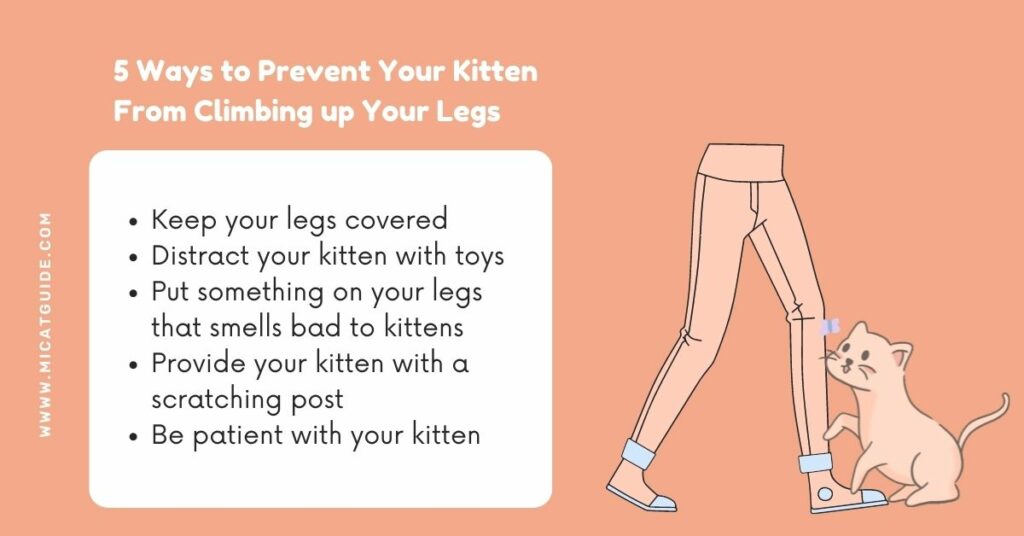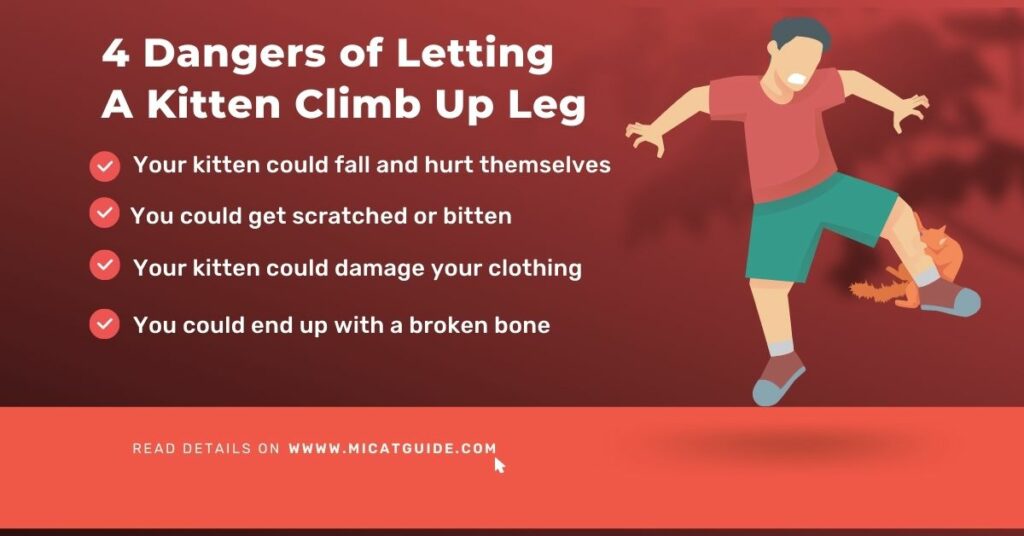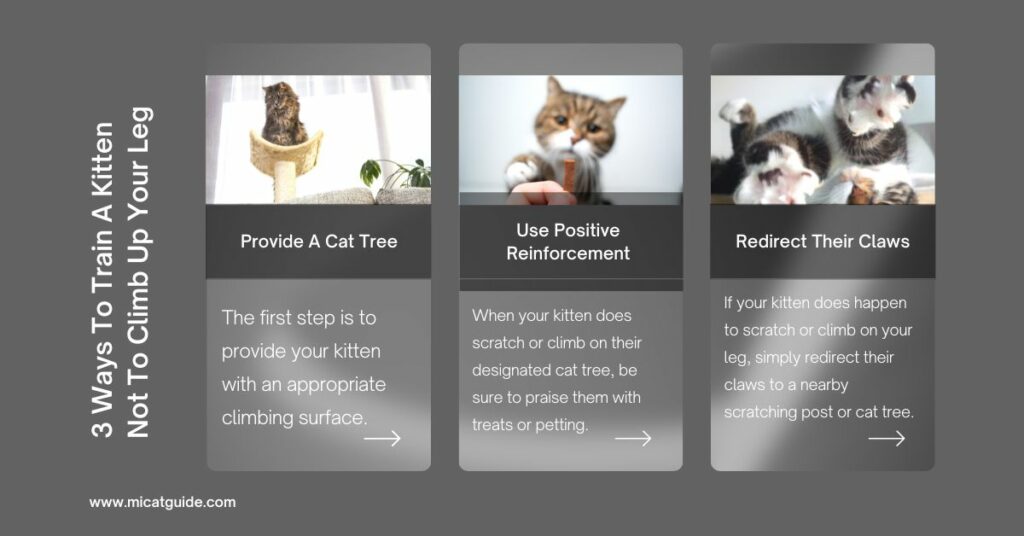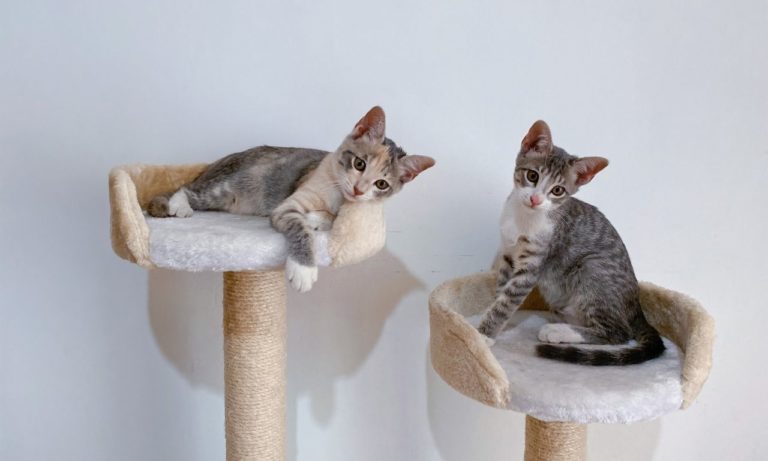How to Stop A Kitten from Climbing Up Your Leg?
The minute they grab your leg say “No!” in a firm voice and remove them from your leg. If they cry, give them a little time to calm down before you try again. Be Consistent. Put them down as soon as they grab your leg or start to climb.
Keep repeating this process until they understand that climbing is not allowed. Try using different words such as “off” or “down” instead of “no” if your kitten isn’t responding to “no.” You can also try using a water bottle to spray them lightly when they attempt to climb, but avoid spraying directly in their face.
Here I’ll attempt to explain how I prevented my kitten from climbing up my leg in this article. I’ll also try to offer you some insight into why certain kittens like to climb up people’s legs and what measures you may take to keep your kitten safe while doing so.
Why Do Kittens Like to Climb Up People’s Legs?

Have you ever wondered why your kitten seems to be constantly climbing up your legs? It may seem like a nuisance, but there are actually a few reasons behind this behavior.
1. Kittens associate their human’s legs with trees
Yes, one theory is that kittens associate their human’s legs with trees. After all, they’re about the same height, and offer a similar view of the world.
For a kitten, being up high gives them a sense of security and safety; they can see what’s coming and be ready to race down at a moment’s notice if needed.
2. Kittens think legs are giant cat toys
Another reason kittens might enjoy climbing up your legs is because they think your legs are giant cat toys.
For a kitten, your legs are the perfect size to pounce on, scratch, and bite (not that you want them to do that!).To a kitten, your legs may as well be a big scratching post or piece of cat furniture.
3. Kitten climbing leg for food
Again, this one goes back to the whole ‘kittens think legs are trees’ theory. Many kittens learn that their humans eat at tables, which are tall like trees. So, when they see their human’s legs, they think it’s a good place to beg for food.
4. Kittens are curious by nature
Lastly, it’s important to remember that kittens are curious by nature. They’re constantly exploring their environment and trying to figure out what everything is and how it works.
So it should come as no surprise that they would want to explore your legs!
How to Prevent Your Kitten from Climbing up Your Legs?

Now that you know some of the reasons behind your kitten’s climbing behavior, you may be wondering how to prevent it. Below are five possible ways to go about doing so.
1. Keep your legs covered
One way to prevent your kitten from climbing up your legs is to keep them covered.
This may not be the most ideal solution in the summertime, but wearing long pants or leggings can help deter your kitten from climbing. If you must wear shorts or a skirt, try to keep them as close to the ground as possible.
2. Distract your kitten with toys
Another way to prevent your kitten from climbing up your legs is to distract them with toys. wave a string toy around, or dangle a piece of yarn in front of their face.
As long as you keep their attention on the toy, they shouldn’t be able to focus on climbing your legs.
3. Put something on your legs that smells bad to kittens
You can also try putting something on your legs that smells bad to kittens, such as lemon juice or vinegar. This won’t hurt them, but the scent will likely deter them from wanting to climb.
4. Provide your kitten with a scratching post
If your kitten is climbing your legs because they think they’re a giant cat toy, then you can try providing them with a scratching post. This will give them a place to scratch and bite that isn’t your legs!
5. Be patient with your kitten
Lastly, it’s important to be patient with your kitten. They’re still exploring their world and trying to figure things out, so it’s natural for them to want to climb your legs.
Just be patient and wait it out, and eventually they’ll grow out of this phase.
Some Dangers of Letting a Kitten Climb Up Your Leg
Even though there are some reasons behind your kitten’s climbing behavior, it’s important to be aware of the dangers of letting them do so. Here are a few dangers to keep in mind.

1. Your kitten could fall and hurt themselves
If your kitten falls while climbing up your legs, they could seriously injure themselves. This is especially true if they’re climbing high enough to reach your head or face.
2. You could get scratched or bitten
Another danger of letting your kitten climb up your legs is that you could end up getting scratched or bitten. This is because their claws are sharp and their teeth are pointy!
3. Your kitten could damage your clothing
If your kitten climbs up your legs while you’re wearing skirts or shorts, they could easily damage your clothing. Their claws can snag fabric and their teeth can leave holes.
4. You could end up with a broken bone
Lastly, if your kitten climbs up your legs and jumps onto your head or face, you could end up with a broken bone. This is because their weight is not evenly distributed, which puts all of the pressure on one small area.
How to Train a Kitten Not to Climb Up Your Leg?

As any cat lover knows, kittens are natural climbers. Their sharp claws and lithe bodies make it easy for them to scale walls, furniture, and, yes, even legs.
While this climbing instinct is perfectly normal, it can also be quite dangerous, both for the kitten and for the unsuspecting human who happens to be in its path. So what can you do to prevent your kitten from scaling your leg like a tree?
1. Provide a Cat Tree
The first step is to provide your kitten with an appropriate climbing surface. A cat tree is the perfect solution, as it gives them a place to scratch, climb, and explore without damaging your furniture or leg.
2. Use Positive Reinforcement
When your kitten does scratch or climb on their designated cat tree, be sure to praise them with treats or petting. This will reinforce the desired behavior and help them to understand that this is where they are supposed to scratch and climb.
3. Redirect Their Claws
If your kitten does happen to scratch or climb on your leg, simply redirect their claws to a nearby scratching post or cat tree. This will help them to understand that their claws belong on the scratching post, not on your leg.
Tips for Keeping Your Kitten Safe While They’re Climbing

Now that you know how to train your kitten not to climb up your leg, it’s important to also take some precautions to keep them safe while they’re climbing. Here are a few tips to keep in mind.
1. Keep an Eye on Them
Whenever your kitten is climbing, be sure to keep an eye on them. This way, you can make sure that they don’t fall and hurt themselves.
2. Keep Their Claws Trimmed
It’s also important to keep your kitten’s claws trimmed. This will help to prevent them from accidentally scratching or piercing your skin if they do happen to climb on you.
3. Use a Leash
If you’re really worried about your kitten getting hurt, you can also use a leash to help keep them safe. This way, you can control their climbing and make sure that they don’t go too high.
Closing Thoughts
Kittens are natural climbers, but that doesn’t mean that they should be climbing up your leg. By providing them with a designated climbing surface and using positive reinforcement, you can train your kitten not to climb on you.
And by taking some safety precautions, you can protect yourself from getting scratched or bitten. So keep these tips in mind and enjoy your climbing kitten!







Hi I have a 10week old kitten and all she does is climb my legs and my legs are all marked up. I can not wear shorts and I use a water gun and it seems not to help. Can you please help me cause it hurts when she climbs up them.